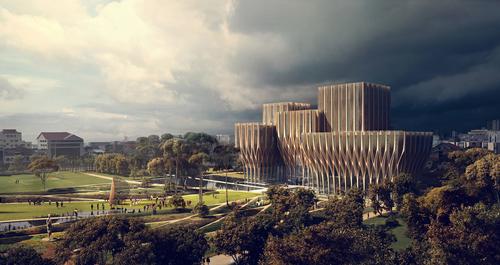17 Oct 2014
Zaha Hadid reveals plans for Cambodian genocide research centre and memorial
BY Tom Anstey

Zaha Hadid Architects has revealed plans for a new museum, school, library and centre for the research of genocide in Phnom Penh, Cambodia.
The project is the architecture firm's first project in Cambodia and its first ever wooden construction. The centre will be a place for the Sleuk Rith Institute to compile, analyse and preserve information related to the Khmer Rouge era of genocide – which saw an estimated death toll of between 740,000 and 3,000,000. The site, adjacent to a public library and law faculty of the royal university of law and economics, was donated by the Cambodian government in 2008.
The Sleuk Rith Institute will not only focus on the past, but will seek to create an institute looking to the future; a place for new generations to learn from the lessons of the tragedies of the past, exploring ways to heal and move forward.
The institute’s design is organised as five wooden structures that are separate volumes at ground level, but interweave and link together as they rise upwards; connecting the different departments, visitors, students and staff within a singular whole.
Each of these five buildings will house a different function: the Sleuk Rith Institute; a library holding the largest collection of genocide-related material in Southeast Asia; a graduate school focussing on genocide, conflicts and human rights studies; a research centre and archive to influence national and regional policies and discourse; a media centre and an auditorium that can be used by the institute and the entire community.
The facility’s museum will house exhibitions showcasing Cambodian artefacts, documents and artworks spanning from Angkor heritage, through to Khmer Rouge documents to contemporary artworks.
The institute will also include a 68,000sq m (731,945sq ft) memorial park for the entire community, with sports fields, urban vegetable gardens and fruit orchards. There will also be traditional meadows and a forest that will house contemporary Cambodian sculptures – many of these commemorating the women that helped to rebuild the country.
Close Window